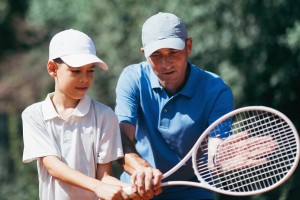 When you enroll your child in a summer tennis camp in Toronto, they will learn valuable lessons about the game. Healthy competition, strategic thinking, moving their feet, and rallying the ball back and forth puts both the mind and body to the test in a fun way.
When you enroll your child in a summer tennis camp in Toronto, they will learn valuable lessons about the game. Healthy competition, strategic thinking, moving their feet, and rallying the ball back and forth puts both the mind and body to the test in a fun way.
Whether your child is attending a tennis summer camp in Toronto for the first time or is already a familiar with the various techniques after attending other tennis camps, you can be confident that your child will learn exact tennis technique that will help them master the game.
Here are four important tennis lessons your child will learn at a summer tennis camp for kids.
Correct Tennis Stance
Tennis uses all parts of the body, but the player’s stance or foot placement is especially vital. Players need to know that there are actually four key stances in the game:
- Open (backhand): The player keeps their lower body towards the net while their upper body turns away to create a spring-like swing to hit the ball.
- Neutral: Also known as the square stance, the player keeps their left foot at almost 90 degrees to the net and the other foot parallel to the baseline. This can create a power swing from further back on the court.
- Semi-Open: In the stance between neutral and open, the player keeps their feet at 45 degrees to the baseline and has a better positioning to hit short balls.
- Closed: The player keeps both feet parallel with the baseline, pointed either left or right of the court, allowing them to have a better backhand shot.
Path of Swing
A player’s path of swing is a combination of their handling of the racquet from their preferred swing arm, plus how they grip the racquet. A correct path of swing will ensure that the ball goes exactly where the player intends for it to go. Many beginners often make the mistake of hitting down on the ball, which will make the ball hit the net. Instead, children should learn to swing their racquet from low to high, with the racquet finishing above their shoulder.
Varied Grips
If you’ve ever looked at a racquet handle up-close, you’ll notice that it’s octagonal, with eight bevels or numbers etched on the base. These bevels provide orientation for the player’s grip. There are three primary grips your child will learn at tennis camp:
- The continental—a.k.a. the “chopper” or “hammer” grip—where the player keeps the index finger knuckle on bevel two for better serves.
- The eastern grip, which requires the player to place their index finger knuckle on bevel three for flatter groundstrokes.
- The semi-western grip, where the index finger knuckle is on bevel four. This is used for more aggressive shots.
- There are also secondary grips of these three primary grips, using the other bevels, which will be covered in further lessons.
How to Serve
Learning to correctly serve is a vital part of a great tennis lesson. Positioning your feet, bending your knees, and pushing one’s body into the swing to serve—it’s a science in itself. Later, specific serves like the slice, kick, twist, and underhand are covered.
Enroll Your Kids in a Summer Tennis Camp in Toronto
Interested in a great summer tennis camp program in Toronto? Bayview Village Tennis Camp is the best tennis camp for kids in Toronto. Our Tennis Canada-certified instructors work to teach kids not only how to have fun with tennis, but also how to play smart and safe.
Our camp employs experienced instructors that know the tips and tricks to help your child learn how to play their best with their mind and body. To learn more about our various tennis programs, call us at (905) 889-7293 or email pnielsen889@rogers.com.